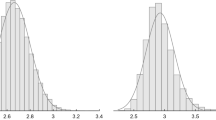Abstract
The ‘beta’ is one of the key quantities in the capital asset pricing model (CAPM). In statistical language, the beta can be viewed as the slope of the regression line fitted to financial returns on the market against the returns on the asset under consideration. The insurance counterpart of CAPM, called the weighted insurance pricing model (WIPM), gives rise to the so-called weighted-Gini beta. The aforementioned two betas may or may not coincide, depending on the form of the underlying regression function, and this has profound implications when designing portfolios and allocating risk capital. To facilitate these tasks, in this paper we develop large-sample statistical inference results that, in a straightforward fashion, imply confidence intervals for, and hypothesis tests about, the equality of the two betas.
Similar content being viewed by others
References
K. B. Athreya, “Bootstrap of the Mean in the Infinite Variance Case”, Ann. Statist. 15, 724–731 (1987).
P. K. Bhattacharya, “Convergence of Sample Paths of Normalized Sum of Induced Order Statistics”, Ann. Statist. 2, 1034–1039 (1974).
P. J. Bickel, F. Götze, and W. R. van Zwet, “Resampling Fewer than n Observations: Gains, Losses, and Remedies for Losses”, Statistica Sinica 7, 1–31 (1997).
B. Brahimi, D. Meraghni, A. Necir, and R. Zitikis, “Estimating the Distortion Parameter of the Proportional-Hazard Premium for Heavy-Tailed Losses”, Insurance:Mathematics and Economics 49, 325–334 (2011).
M. R. Chernick and R. A. LaBudde, An Introduction to Bootstrap Methods with Applications to R (Wiley, New York, 2011).
D. Donaldson and J. A. Weymark, “A Single-Parameter Generalization of the Gini Indices of Inequality”, J. Economic Theory 22, 67–86 (1980).
E. Furman and R. Zitikis, “Weighted Risk Capital Allocations”, Insurance:Mathematics and Economics 43, 263–269 (2008).
E. Furman and R. Zitikis, “Weighted Pricing Functionals with Application to Insurance: An Overview”, North Amer. Actuar. J. 13, 483–496 (2009).
E. Furman and R. Zitikis, “General Stein-Type Covariance Decompositions with Applications to Insurance and Finance”, ASTIN Bulletin 40, 369–375 (2010).
E. Furman and R. Zitikis, “Beyond the Pearson Correlation: Heavy-Tailed Risks, Weighted Gini Correlations, and a Gini-TypeWeighted Insurance PricingModel”, ASTIN Bulletin 47, 919–942 (2017).
N. V. Gribkova and R. Helmers, “On the Edgeworth Expansion and the M-out-of-N Bootstrap Accuracy for a Studentized TrimmedMean”, Math. Methods of Statist. 16, 142–176 (2007).
N. V. Gribkova and R. Helmers, “On the Consistency of the M<< N Bootstrap Approximation for a Trimmed Mean”, Theory Probab. and Its Appl. 55, 42–53 (2011).
P. Hall, The Bootstrap and Edgeworth Expansion (Springer, New York, 1992).
B. L. Jones and R. Zitikis, “Risk Measures, Distortion Parameters, and Their Empirical Estimation”, Insurance: Mathematics and Economics 41, 279–297 (2007).
N. C. Kakwani, Income Inequality and Poverty:Methods of Estimation and Policy Applications (Oxford Univ. Press, New York, 1980).
H. Levy, “The CAPM is Alive and Well: A Review and Synthesis”, European Financial Management 16, 43–71 (2010).
H. Levy, The Capital Asset Pricing Model in the 21st Century: Analytical, Empirical, and Behavioral Perspectives (Cambridge Univ. Press, Cambridge, 2011).
A. J. McNeil, R. Frey, and P. Embrechts, Quantitative Risk Management: Concepts, Techniques and Tools, Revised ed. (Princeton Univ. Press, Princeton, NJ, 2015).
E. Mammen, When Does Bootstrap Work? Asymptotic Results and Simulations (Springer, New York, 1992).
A. Necir and D. Meraghni, “Empirical Estimation of the Proportional Hazard Premium for Heavy-Tailed Claim Amounts”, Insurance:Mathematics and Economics 45, 49–58 (2009).
A. Necir, D. Meraghni, and F. Meddi, “Statistical Estimate of the Proportional Hazard Premium of Loss”, Scand. Actuar. J. 2007, 147–161 (2007).
V. V. Petrov, Sums of Independent Random Variables (Springer, New York, 1975).
J. Quiggin, Generalized Expected Utility Theory (Kluwer, Dordrecht, 1993).
C. R. Rao and L. C. Zhao, “Convergence Theorems for Empirical Cumulative Quantile Regression Function”, Math.Methods of Statist. 4, 81–91 (1995).
A. Sandström, Handbook of Solvency for Actuaries and RiskManagers: Theory and Practice (Chapman and Hall/CRC, Boca Raton, FL, 2010).
N. Sawyer, Basel III: Addressing the Challenges of Regulatory Reform (Risk Books, London, 2012).
G. R. Shorack, “Functions of Order Statistics”, Ann. Math. Statist. 43, 412–427 (1972).
J. Su, Multiple Risk Factors Dependence Structures with Applications to Actuarial RiskManagement, Ph.D. Thesis (York Univ., Ontario, Canada, 2016).
J. Su and E. Furman, “A Form of Multivariate Pareto Distribution with Applications to Financial Risk Measurement”, ASTIN Bulletin 47, 331–357 (2017).
S.M. Tse, “On the Cumulative Quantile Regression Process”, Math.Methods Statist. 18, 270–279 (2009).
S.M. Tse, “The Cumulative Quantile Regression Function with Censored and Truncated Response”, Math. Methods Statist. 24, 147–155 (2015).
W. R. van Zwet, “A Strong Law for Linear Functions of Order Statistics”, Ann. Probab. 8, 986–990 (1980).
J. von Neumann and O. Morgenstern, Theory of Games and Economic Behavior (Princeton Univ. Press, Princeton, NJ, 1944).
S. Wang, “Insurance Pricing and Increased Limits Rate Making by Proportional Hazards Transforms”, Insurance: Mathematics and Economics 17, 43–54 (1995).
S. S. Yang, “Linear Combinations of Concomitants of Order Statistics with Application to Testing and Estimation”, Ann. Inst. Statist. Math. 33, 463–470 (1981).
R. Zitikis and J. L. Gastwirth, “Asymptotic Distribution of the S-Gini Index”, Australian and New Zealand J. of Statist. 44, 439–446 (2002).
Author information
Authors and Affiliations
Corresponding author
About this article
Cite this article
Gribkova, N., Zitikis, R. Statistical foundations for assessing the difference between the classical and weighted-Gini betas. Math. Meth. Stat. 26, 267–281 (2017). https://doi.org/10.3103/S1066530717040020
Received:
Published:
Issue Date:
DOI: https://doi.org/10.3103/S1066530717040020




